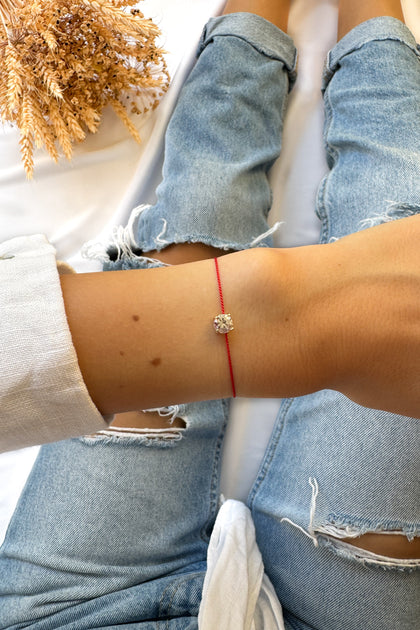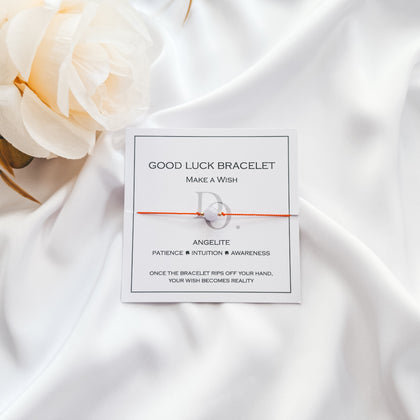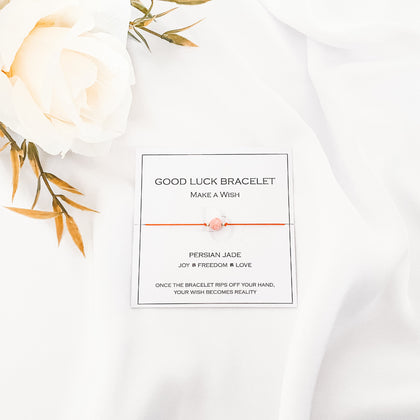The Lucky Edit by Do.Dreamss
Spiritual Jewelry Meanings: Finding Protection and Purpose in Accessories
Spiritual jewelry stands as a profound bridge between the material and metaphysical worlds—transcending mere decoration to embody our deepest beliefs, cultural heritage, and personal intentions. These meaningful accessories serve as constant companions in our daily lives, offering protection, purpose, and a tangible connection to our faith and identity. From ancient amulets to modern talismans, these pieces whisper stories of tradition while reflecting our individual spiritual journeys. As we embrace luck and protection through the world of Do.Dreamss, we discover how these symbolic adornments can transform our experience, offering both beauty and profound significance in our increasingly chaotic world.
The origins and evolution of spiritual jewelry
Throughout human history, jewelry has evolved from simple adornment to powerful spiritual tools. Archaeological discoveries reveal that our ancestors wore symbolic pieces not just for decoration, but as conduits to divine protection and spiritual connection. This transformation represents humanity's enduring quest to manifest belief in tangible form.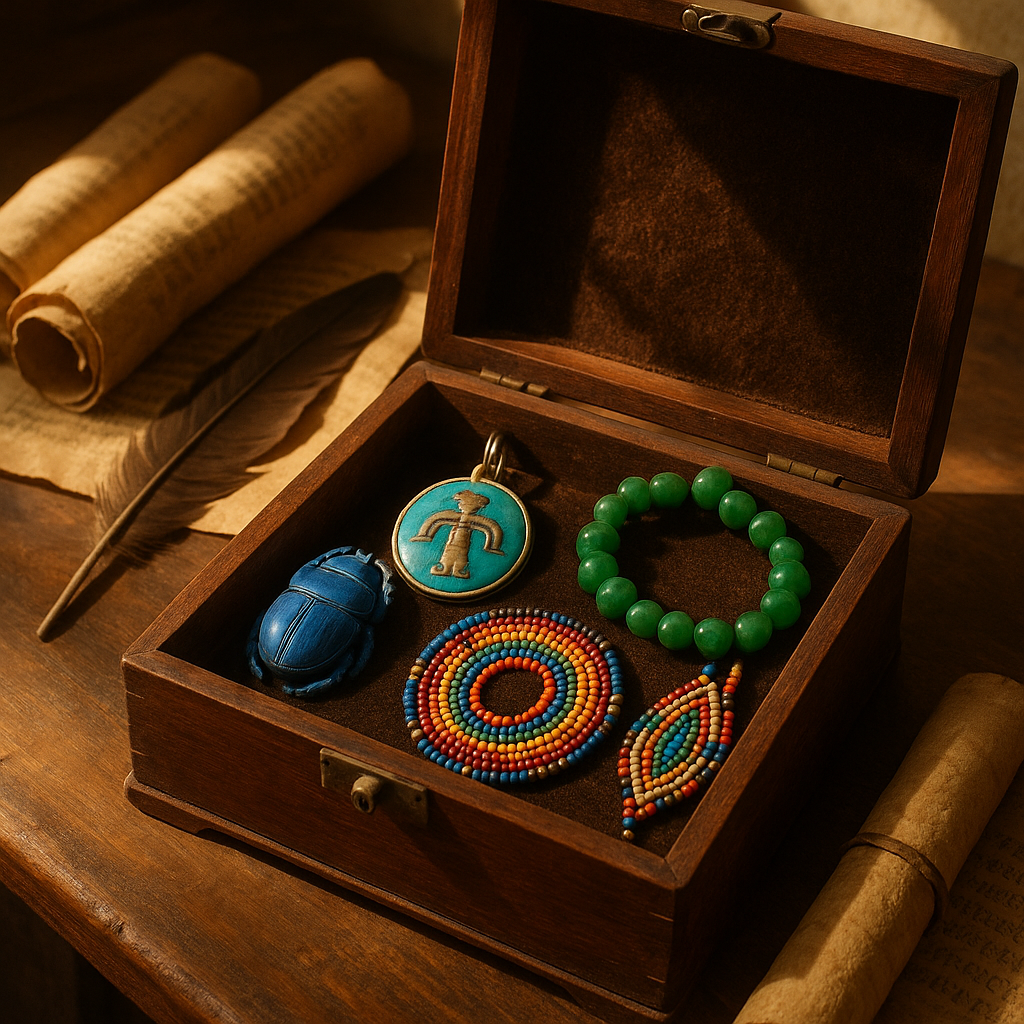
Ancient Egyptian royalty adorned themselves with scarab beetles symbolizing rebirth, while eye of Horus pendants offered divine protection. Native American cultures created intricate pieces incorporating natural elements like turquoise—believed to connect wearers to sky spirits and promote healing. Across Asian traditions, jade pendants served as conduits of balance and harmony, while African cultures developed elaborate beaded works encoding ancestral wisdom and tribal identity.
The materials themselves carried significance beyond their aesthetic value. Gold represented divine connection and immortality across many cultures due to its unchanging nature. Silver, associated with lunar energy, was believed to ward off negative forces, while copper was prized for its alleged healing properties in treating joint inflammation and improving circulation.
Sacred symbols across civilizations
The universal language of spiritual symbolism crossed cultural boundaries, revealing shared human concerns about protection, prosperity, and divine connection. The lotus flower emerged independently across Egyptian and Eastern traditions as a powerful representation of spiritual awakening and purity. Similarly, spiral motifs appeared in Celtic, Greek, and indigenous American jewelry, symbolizing the eternal cycle of life, death, and rebirth.
What began as localized traditions eventually transformed through cultural exchange along ancient trade routes. Mediterranean sailors adopted Middle Eastern protective symbols, while Buddhist imagery gradually influenced designs across East Asia. Today's spiritual jewelry market reflects this rich multicultural heritage, offering authentic connections to ancient wisdom. If you're drawn to these meaningful traditions, you might want to explore meaningful accessory collections that honor these time-tested symbols.
Common spiritual symbols and their meanings
Today's spiritual jewelry marketplace showcases an extraordinary diversity of symbols drawn from traditions worldwide. Understanding the deeper significance behind these powerful motifs can help you select pieces that truly resonate with your spiritual journey and personal intentions.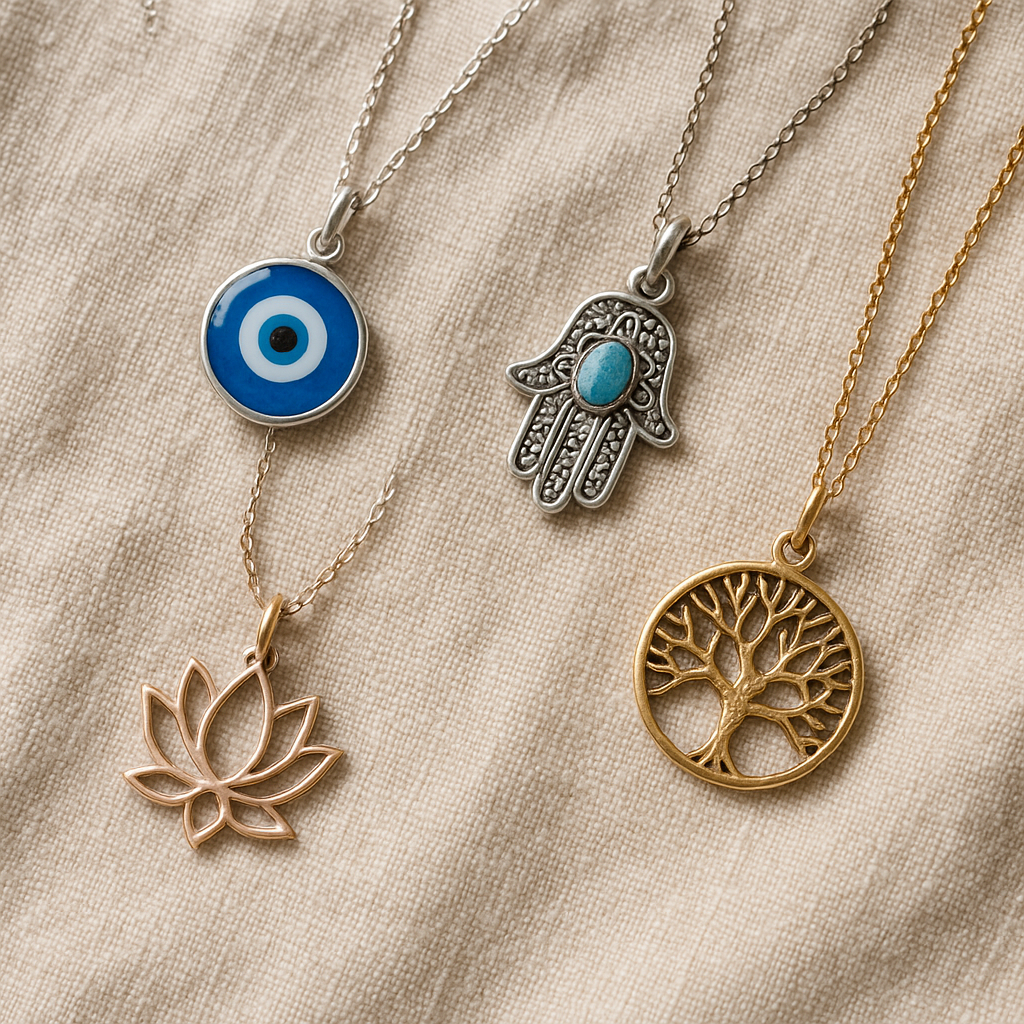
Evil eye (Nazar)
The evil eye necklace meaning centers around protection from malevolent gazes and negative energies. This symbol—typically depicted as a blue eye—originated in Mediterranean and Middle Eastern cultures over 5,000 years ago. The specific colors used carry distinct purposes: blue represents protection and karma, white symbolizes purity and good intentions, while red offers strength and courage.
Contemporary wearers embrace evil eye jewelry as both a protective talisman and a fashion statement that transcends its religious origins. Turkish tradition suggests the nazar works by absorbing negative energy until it eventually cracks, having fulfilled its protective purpose.
Hamsa hand
Hamsa jewelry symbolism spans multiple faith traditions, appearing in both Jewish (as the Hand of Miriam) and Islamic (as the Hand of Fatima) contexts. This palm-shaped amulet with an eye in its center serves as a powerful shield against the evil eye while promoting happiness, peace, and prosperity.
The hamsa's five fingers represent either the five books of the Torah in Judaism or the Five Pillars of Islam in Muslim tradition. When worn with fingers pointing down, it invites abundance and fertility; when fingers point upward, it offers protection from negative influences. Modern designers often incorporate gemstones into hamsa jewelry to enhance specific intentions—amethyst for spiritual awareness or turquoise for healing energy.
Lotus flower and tree of life
The lotus flower symbolizes spiritual awakening and enlightenment in Buddhist and Hindu traditions. Because this beautiful bloom rises from murky waters to produce immaculate petals, it represents the soul's journey from material attachment to spiritual purity. Jewelry featuring this motif serves as a gentle reminder of personal growth and transformation.
The tree of life appears across numerous spiritual and cultural traditions, from ancient Celtic designs to Jewish mysticism. With its branches reaching skyward and roots delving deep, it symbolizes the interconnectedness of all creation and the bridge between earthly and spiritual realms. Wearing this symbol promotes feelings of groundedness and universal connection during life's challenges.
Moon, sun, angel wings, and heart
Celestial symbols carry profound spiritual significance across cultures. Moon jewelry traditionally embodies feminine energy, intuition, and emotional cycles. In contrast, sun motifs represent masculine energy, vitality, and illumination. Many spiritual practitioners wear both to promote internal balance between opposing energies.
Angel wing jewelry serves as a comforting reminder of spiritual guidance and protection, particularly popular among those seeking connection with departed loved ones or divine messengers. Heart symbols, while commonly associated with romantic love, also represent spiritual concepts of compassion, divine love, and the soul's center in many mystical traditions.
Jewelry for protection, intention, and purpose
Beyond their visual appeal, spiritual jewelry pieces serve practical metaphysical functions in the lives of their wearers. Understanding these distinct purposes can help you select pieces aligned with your specific spiritual needs and intentions.
Protection jewelry serves as a spiritual shield, creating an energetic barrier between the wearer and negative influences. Traditional amulets like the Italian cornicello (horn) or Turkish nazar function as talisman meaning to deflect harm rather than attract good fortune. Many protection pieces incorporate specific materials believed to amplify their defensive properties—black tourmaline for grounding negative energy or obsidian for creating psychic barriers.
Intention-setting jewelry acts as a physical anchor for manifestation practices. These pieces often incorporate elements like healing crystal jewelry selected for specific vibrational qualities. Amethyst promotes calm and spiritual awareness, while rose quartz attracts love and compassion. Clear quartz amplifies any intention, making it particularly popular for personalized manifestation jewelry.
Many modern spiritual jewelry designers combine ancient symbolism with contemporary mindful accessories. These pieces may incorporate affirmation engravings, birthstones aligned with chakra energy, or personal totems that resonate with the wearer's spiritual path. Some practitioners enhance their jewelry's effectiveness through energy-charging rituals involving moonlight, sunlight, or sound vibrations.
How to set and amplify your intention
Maximizing the effectiveness of spiritual jewelry involves more than simply wearing it. Many practitioners recommend an intentional process beginning with cleansing newly acquired pieces to remove any accumulated energies from previous handlers. Methods include passing jewelry through sage smoke, placing it on selenite crystals, or allowing it to rest in moonlight.
Once cleansed, take time to program your jewelry with specific intentions. Hold the piece in your dominant hand while clearly visualizing your desired outcome.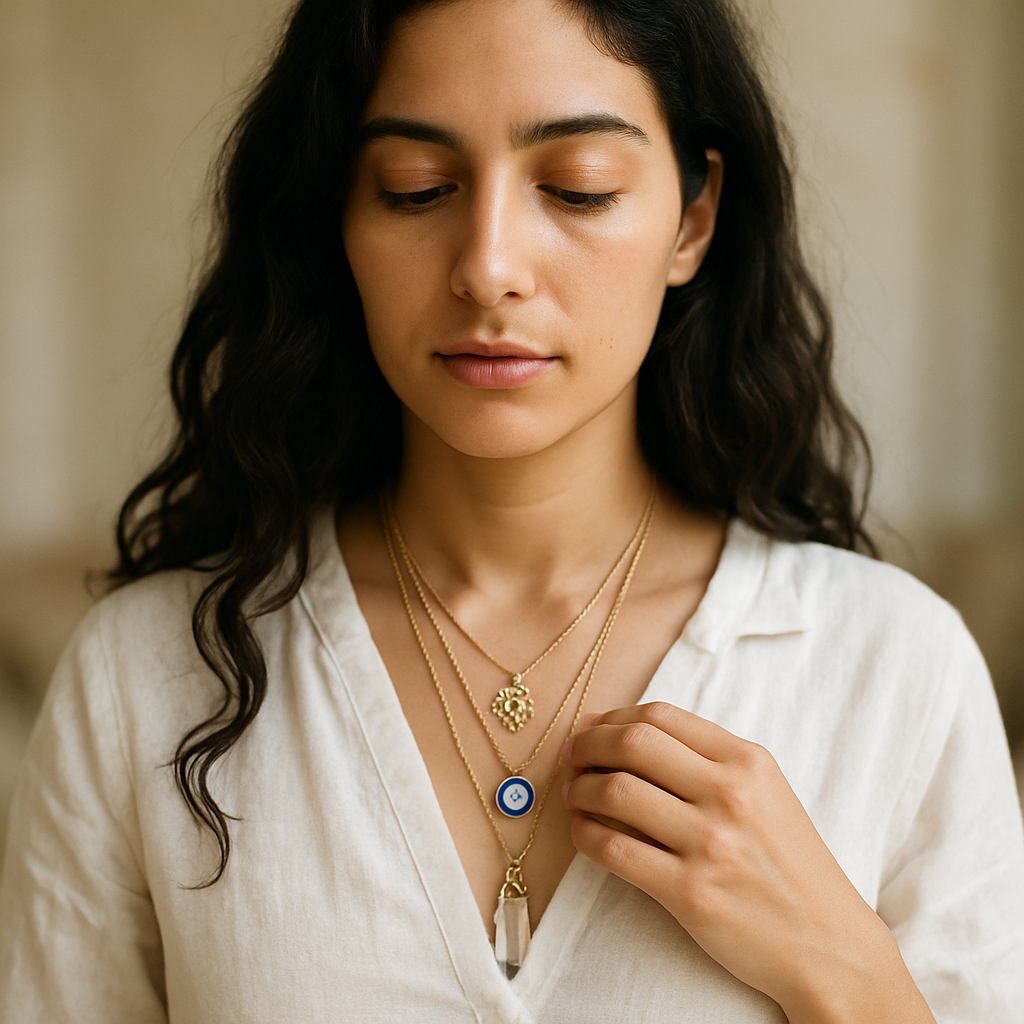
Some practitioners enhance this process by speaking affirmations aloud while touching the jewelry. Regular "recharging" through similar methods helps maintain the piece's energetic potency over time. For more approaches to personal talismans, see recent articles on personal talismans that explore this practice in greater depth.
Personalizing and choosing spiritual jewelry that resonates
Finding spiritual jewelry that truly resonates requires looking beyond trends to discover pieces that authentically align with your personal journey. This process combines aesthetic preferences with deeper spiritual considerations.
Begin by clarifying your primary purpose—whether protection, manifestation, healing, or connection to specific spiritual traditions. This intention will guide your selection process toward symbols and materials that serve your unique needs. Consider your cultural heritage and spiritual practices, as jewelry that honors these connections often carries particular significance.
Personal resonance remains the most important factor when selecting spiritual jewelry. Many practitioners describe experiencing physical sensations like warmth, tingling, or a sense of calm when handling pieces that align with their energy. Trust these intuitive responses as valuable guidance.
Beyond traditional symbols, consider personalized elements like birthstones, astrological correspondences, or engraved mantras meaningful to your spiritual path. Modern trends embrace layering different symbolic pieces—such as combining protection symbols with intention crystals—for a personalized spiritual toolkit that evolves with your journey. Whatever speaks to you, you can shop symbolic jewelry styles that align with your unique spiritual perspective.
Gift-giving and heirloom value
Spiritual jewelry makes particularly meaningful gifts when selected with the recipient's beliefs and needs in mind. Consider their spiritual practices, cultural background, and current life challenges when choosing symbolic pieces. A protection amulet might benefit someone facing difficult transitions, while intention-setting jewelry could support another in manifesting new beginnings.
These meaningful accessories often become cherished family heirlooms, gaining energetic potency as they pass between generations.
Many cultures believe that spiritual jewelry absorbs the wisdom and protective energy of previous wearers, creating powerful connections across time. When gifting such pieces, consider including a note explaining the symbol's significance and your intentions behind the gift.
Caring for and honoring your meaningful jewelry
Proper care for spiritual jewelry encompasses both physical maintenance and energetic cleansing. These special pieces require attention to both their material form and metaphysical properties to maintain their beauty and effectiveness.
For physical maintenance, follow care guidelines appropriate to your jewelry's materials. Silver requires periodic polishing to prevent tarnishing, while certain gemstones may be sensitive to sunlight or harsh chemicals. Store spiritual pieces separately from everyday jewelry, ideally wrapped in natural fibers like silk or cotton rather than synthetic materials that may trap energies.
Energetic maintenance proves equally important for maintaining your jewelry's spiritual properties. Many traditions recommend regular cleansing to remove accumulated negative energies. Methods include moonlight bathing during full moons, brief immersion in salt water (if appropriate for the materials), smudging with sacred herbs, or placement on cleansing crystals like selenite or clear quartz clusters.
Beyond cleansing, consider periodically "recharging" your jewelry through meditation while holding the piece, placing it on personal altars during significant spiritual moments, or exposing it to the energies of special places during your travels. These practices help maintain and deepen your connection to your spiritual accessories.
Honoring symbol origins
Ethical considerations matter when wearing symbols from spiritual traditions not personally connected to your heritage. Approach such pieces with respect and understanding rather than merely appreciating their aesthetic appeal. Take time to learn about symbols' cultural significance, traditional uses, and appropriate wearing practices.
Some symbols carry specific religious meanings that may make casual wear inappropriate. For example, certain Native American motifs hold sacred significance that should be respected rather than appropriated. When drawn to symbols outside your cultural tradition, seek pieces created by artisans from those traditions who understand the proper representations and contexts. Explore collections with ethical sourcing and conscious design to ensure your spiritual jewelry honors its origins.
Remember that spiritual jewelry represents more than personal style—it connects to living traditions, cultural histories, and sacred practices deserving of respect. This mindful approach enhances both the meaning and effectiveness of your spiritual accessories.
Conclusion
Spiritual jewelry transcends ordinary accessories by connecting us to something greater—whether ancient wisdom, protective forces, personal intentions, or our authentic spiritual identity. These meaningful pieces serve as daily companions in our spiritual journey, offering tangible reminders of our deepest values and aspirations.
As you explore the rich world of spiritual jewelry, approach your selections mindfully. Consider which symbols genuinely resonate with your path, select pieces that honor their cultural origins, and maintain both their physical beauty and energetic properties through proper care. Whether seeking protection from challenging energies, manifesting new possibilities, or connecting to spiritual traditions, the right symbolic jewelry becomes an extension of your highest self.
Remember that these special accessories gain power through your relationship with them—your belief, intention, and the meaning you invest in them. By selecting pieces that genuinely speak to your spirit and honoring them appropriately, you transform simple adornments into powerful allies on your unique journey. The perfect spiritual jewelry doesn't just decorate your appearance—it reflects and amplifies who you truly are.
Frequently asked questions
-
What is spiritual jewelry and how does it differ from regular jewelry?
Spiritual jewelry carries symbolic, protective, or intention-based meaning—often rooted in cultural or religious tradition—whereas regular jewelry is usually ornamental. -
Does wearing protective jewelry like the evil eye or hamsa really work?
Many believe these symbols influence energy and intention; their effectiveness often depends on personal belief and cultural context. -
How do I choose the right spiritual symbol or stone for me?
Pick symbols or gemstones that resonate with your beliefs, desired intention, or personal connection. -
Can I layer multiple spiritual necklaces and charms?
Yes—mixing symbols (e.g., hamsa and evil eye) is common for added protection and personal style. -
What are best practices for cleansing or recharging spiritual jewelry?
Use mindful methods such as sage smudging, moonlight, or simple cleaning rituals to refresh both the physical and energetic aspects.


